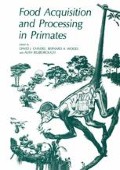Abstract
It is now widely recognised that during the early Pleistocene there were at least two distinct hominid lineages (Tobias, 1973; Leakey and Walker, 1976; White, Johanson and Kimbel, 1981; Wood, 1981). Whatever the nomenclatural devices used, there is also widespread agreement that one lineage contains, or leads to, the group we know informally as the ‘robust’ australopithecines. Most workers also accept that the specialisations which demarcate that lineage are most developed within the hypodigm of Australopithecus (Paranthropus) boisei. The first attempt to define the functional adaptations underlying the evolution of ‘robust’ australopithecines (what Tattersall and Eldredge (1977) call the evolutionary ’scenario’) was made three decades or more ago (Robinson, 1954) and since then nearly all such attempts have identified characteristic features of the teeth, jaws and cranium and stressed their likely association with particular dietary and feeding regimes (Robinson, 1963; Jolly, 1970; Du Brul, 1977; Walker, 1981). Before one can proceed to postulate hypothetical scenarios, however, it is most important to examine whether the basis for identifying the morphological sets, or phena, is a sound one. Even though the case for the distinctiveness of the ‘robust’ australopithecines is widely accepted, there is much less agreement about the taxonomic and functional implications of the features cited. In particular, there is discussion about whether the apparently distinctive morphological features are not simply the scale effects of a larger body size, rather than evidence of more profound functional modifications. In this paper I will discuss the general problem of how such assessments are made, and examine two examples which relate to dental morphology. The first is the relationship between canine and molar size and between canine/molar size and body size, and the second is the link, if any, between overall size and the relative cusp size of mandibular molar teeth.
Access this chapter
Tax calculation will be finalised at checkout
Purchases are for personal use only
Preview
Unable to display preview. Download preview PDF.
References
Cheverud, J.M. (1982) Relationship among ontogenetic, static and evolutionary allometry. Am. J. phys. Anthrop. 59: 139–149.
DuBrul, E.L. (1977) Early hominid feeding mechanisms. Am. J. phys. Anthrop. 47: 305–320.
Gingerich, P.D., Smith, B.H. and Rosenberg, K. (1982) Allometric scaling in the dentition of primates and prediction of body weight from tooth size in fossils. Am. J. phys. Anthrop. 58: 81–100.
Gould, S.J. (1966) Allometry and size in ontogeny and phylogeny. BioZ. Rev. 41: 587–640.
Gould, S.J. (1975) Allometry in primates, with emphasis on scaling and_the evolution of the brain. In “Approaches to Primate Paleobiology” ( F.S. Szalay, ed.), pp. 244–292. Karger, Basel.
Harvey, P.H., Kavanagh, M. and Clutton-Brock, T.H. (1978) Sexual dimorphism in primate teeth. J. Zool. (Lond.) 186: 475–485.
Huxley, J.S. and Teissier, G. (1936) Zur terminologie des relativen Grössenwachstums. Biol. ZbZ. 56: 381–383.
Jolly, C.J. (1970) The seed eaters: a new model of hominid differentiation based on a baboon analogy. Man 5: 5–26.
Kay, R.F. (1975) The functional adaptations of primate molar teeth. Am. J. phys. Anthrop. 43: 195–216.
Leakey, R.E.F. and Walker, A.C. (1976) Australopithecus, Homo erectus and the single species hypothesis. Nature 261: 572–574.
McHenry, H.M. and Corruccini, R.S. (1980) Late tertiary hominoids and human origins. Nature 285: 397–398.
Pilbeam, D. and Gould, S.J. (1974) Size and scaling in human evolution. Science 186: 892–901.
Robinson, J.T. (1954) The genera and species of the Australo- pithecinae. Am. J. phys. Anthrop. 12: 181–200.
Robinson, J.T. (1963) Adaptive radiation in the australopithecines and the origin of man. In “African Ecology and Human
Evolution“ (F.C. Howell and F. Bourliere, eds.), pp. 385–416. Aldine, Chicago.
Smith, R.J. (1981a) On the definition of variables in studies of primate dental allometry. Am. J. phys. Anthrop. 55: 323–329.
Smith, R.J. (1981b) Interspecific scaling of maxillary canine size and shape in female primates: relationships to social structure and diet. J. Hum. Evol. 10: 165–173.
Tattersall, I. and Eldredge, N. (1977) Fact, theory and fantasy in human paleontology. Am. Scient. 65: 204–211.
Tobias, P.V. (1973) Implications of the new age estimates of the early South African hominids. Nature 246: 79–83.
Walker, A. (1981) Diet and teeth. Dietary hypotheses and human evolution. Philosophical Transactions of the Royal Society of London, Series B. 292: 57–64.
White, T.D., Johanson, D.C. and Kimbel, W.H. (1981) Australopithecus africanus: its phyletic position reconsidered. S. Afr. J. Sci. 77: 445–470.
Wolpoff, M.H. (1976) Primate models for australopithecine sexual dimorphism. Am. J. phys. Anthrop. 45: 497–510.
Wolpoff, M.H. (1978) Some aspects of canine size in the australopithecine.. J. Hum. Evol. 7: 115–126.
Wolpoff, M.H. (1982) Relative canine size. J. Hum. Evol. 10: 151–158.
Wood, B.A. (1978) Models for assessing relative canine size in fossil hominids. J. Hum. Evol. 8: 493–502.
Wood, B.A. (1979) An analysis of tooth and body size relationships in five primate taxa. Folia primatol. 31: 187–211.
Wood, B.A. (1981) Human origins–fossil evidence and current problems of analysis and interpretation. In “Progress in Anatomy”, Vol. 1 ( R.J. Harrison and R.L. Holmes, eds.), pp. 229–245. Cambridge University Press, Cambridge.
Wood, B.A., Abbott, S.A. and Graham, S.H. (1983) Analysis of the dental morphology of Plio-Pleistocene hominids. II. Mandibular molars–study of cusp areas, fissure pattern and cross sectional shape of the crown. J. Anat. 137: 289–316.
Wood, B.A. and Stack, C.G. (1980) Does allometry explain the differences between “gracile” and “robust” australopithecines? Am. J. phys. Anthrop. 52: 55–62.
Author information
Authors and Affiliations
Editor information
Editors and Affiliations
Rights and permissions
Copyright information
© 1984 Springer Science+Business Media New York
About this chapter
Cite this chapter
Wood, B. (1984). Interpreting the Dental Peculiarities of the ‘Robust’ Australopithecines. In: Chivers, D.J., Wood, B.A., Bilsborough, A. (eds) Food Acquisition and Processing in Primates. Springer, Boston, MA. https://doi.org/10.1007/978-1-4757-5244-1_24
Download citation
DOI: https://doi.org/10.1007/978-1-4757-5244-1_24
Publisher Name: Springer, Boston, MA
Print ISBN: 978-1-4757-5246-5
Online ISBN: 978-1-4757-5244-1
eBook Packages: Springer Book Archive

